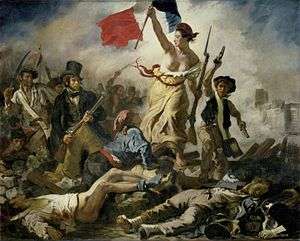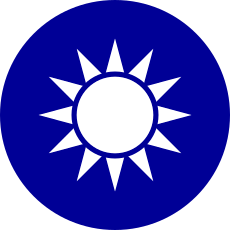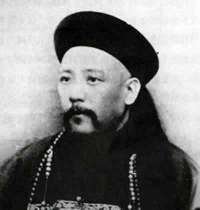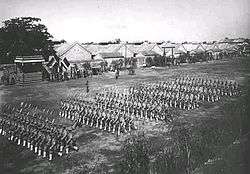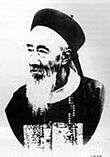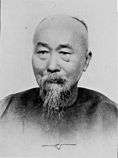Xinhai Revolution
| Xinhai Revolution (Chinese Revolution of 1911) | |||||||
|---|---|---|---|---|---|---|---|
| Part of Anti-Qing Movements | |||||||
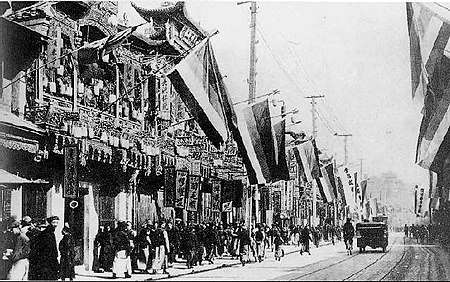 Double Ten Revolution in Shanghai-Nanjing Road (Nanking Road) after the Shanghai Uprising, hung with the Five Races Under One Union flags then used by the revolutionaries in Shanghai and Northern China. | |||||||
| |||||||
| Belligerents | |||||||
|
|
Gelaohui Tiandihui Various other revolutionary groups and forces Regional officials and warlords | ||||||
| Commanders and leaders | |||||||
|
|
| ||||||
| Strength | |||||||
| 200,000 | 100,000 | ||||||
| Casualties and losses | |||||||
| ~170,000 | ~50,000 | ||||||
| Xinhai Revolution | |||||||||||||||||||||||
.svg.png) "Xinhai Revolution" in Chinese characters | |||||||||||||||||||||||
| Chinese | 辛亥革命 | ||||||||||||||||||||||
|---|---|---|---|---|---|---|---|---|---|---|---|---|---|---|---|---|---|---|---|---|---|---|---|
| Literal meaning | "Xinhai (stem-branch) revolution" | ||||||||||||||||||||||
| |||||||||||||||||||||||
The Xinhai Revolution (Chinese: 辛亥革命; pinyin: Xīnhài Gémìng), also known as the Chinese Revolution or the Revolution of 1911, was a revolution that overthrew China's last imperial dynasty (the Qing dynasty) and established the Republic of China (ROC). The revolution was named Xinhai (Hsin-hai) because it occurred in 1911, the year of the Xinhai (辛亥; "metal pig") stem-branch in the sexagenary cycle of the Chinese calendar.[1]
The revolution consisted of many revolts and uprisings. The turning point was the Wuchang uprising on 10 October 1911, which was the result of the mishandling of the Railway Protection Movement. The revolution ended with the abdication of the six-year-old Last Emperor, Puyi, on 12 February 1912, that marked the end of 2,000 years of imperial rule and the beginning of China's early republican era.[2]
The revolution arose mainly in response to the decline of the Qing state, which had proven ineffective in its efforts to modernize China and confront foreign aggression. Many underground anti-Qing groups, with the support of Chinese revolutionaries in exile, tried to overthrow the Qing. The brief civil war that ensued was ended through a political compromise between Yuan Shikai, the late Qing military strongman, and Sun Yat-sen, the leader of the Tongmenghui (United League). After the Qing court transferred power to the newly founded republic, a provisional coalition government was created along with the National Assembly. However, political power of the new national government in Beijing was soon thereafter monopolized by Yuan and led to decades of political division and warlordism, including several attempts at imperial restoration.
The Republic of China in Taiwan and the People's Republic of China on the mainland both consider themselves the legitimate successors to the Xinhai Revolution and honor the ideals of the revolution including nationalism, republicanism, modernization of China and national unity. 10 October is commemorated in Taiwan as Double Ten Day, the National Day of the ROC. In mainland China, Hong Kong, and Macau, the day is celebrated as the Anniversary of the Xinhai Revolution.
Background
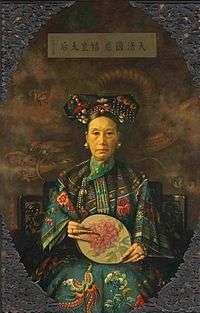
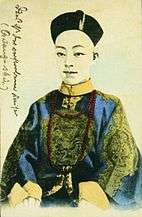
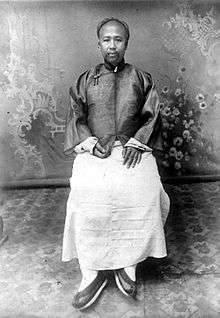
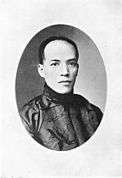
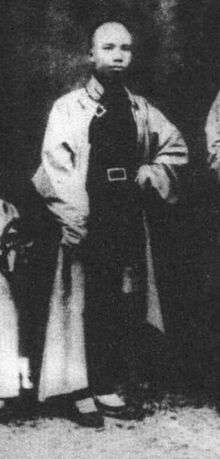
After suffering its first defeat to the West in the First Opium War in 1842, the Qing imperial court struggled to contain foreign intrusions into China. Efforts to adjust and reform the traditional methods of governance were constrained by a deeply conservative court culture that did not want to give away too much authority to reform. Following defeat in the Second Opium War in 1860, the Qing tried to modernize by adopting certain Western technologies through the Self-Strengthening Movement from 1861.[3] In the wars against the Taiping (1851–64), Nian (1851–68), the Muslims of Yunnan (1856–68) and the Northwest (1862–77), the traditional imperial troops proved themselves incompetent and the court came to rely on local armies.[4] In 1895, China suffered another defeat during the First Sino-Japanese War.[5] This demonstrated that traditional Chinese feudal society also needed to be modernized if the technological and commercial advancements were to succeed.
In 1898 the Guangxu Emperor was guided by reformers like Kang Youwei and Liang Qichao for a drastic reform in education, military and economy under the Hundred Days' Reform.[5] The reform was abruptly cancelled by a conservative coup led by Empress Dowager Cixi.[6] The Guangxu Emperor, who had always been a puppet dependent on Cixi, was put under house arrest in June 1898.[4] Reformers Kang and Liang would be exiled. While in Canada, in June 1899, they tried to form the Emperor Protection Society in an attempt to restore the emperor.[4] Empress Dowager Cixi mainly controlled the Qing dynasty from this point on. The Boxer Rebellion prompted another foreign invasion of Beijing in 1900 and the imposition of unequal treaty terms, which carved away territories, created extraterritorial concessions and gave away trade privileges. Under internal and external pressure, the Qing court began to adopt some of the reforms. The Qing managed to maintain its monopoly on political power by suppressing, often with great brutality, all domestic rebellions. Dissidents could operate only in secret societies and underground organizations, in foreign concessions or in exile overseas.
Organization for revolution
Earliest groups
There were many revolutionaries and groups that wanted to overthrow the Qing government to re-establish Han led government. The earliest revolutionary organizations were founded outside of China, such as Yeung Ku-wan's Furen Literary Society, created in Hong Kong in 1890. There were 15 members, including Tse Tsan-tai, who did political satire such as "The Situation in the Far East", one of the first ever Chinese manhua, and who later became one of the core founders of the South China Morning Post.[7]

Sun Yat-sen's Xingzhonghui (Revive China Society) was established in Honolulu in 1894 with the main purpose of raising funds for revolutions.[8] The two organizations were merged in 1894.[9]
Smaller groups
The Huaxinghui (China Revival Society) was founded in 1904 with notables like Huang Xing, Zhang Shizhao, Chen Tianhua and Song Jiaoren, along with 100 others. Their motto was "Take one province by force, and inspire the other provinces to rise up".[10]
The Guangfuhui (Restoration Society) was also founded in 1904, in Shanghai with Cai Yuanpei. Other notable members include Zhang Binglin and Tao Chengzhang.[11] Despite professing the anti-Qing cause, the Guangfuhui was highly critical of Sun Yat-sen.[12] One of the most famous female revolutionaries was Qiu Jin, who fought for women's rights and was also from Guangfuhui.[12]
There were also many other minor revolutionary organizations, such as Lizhi Xuehui (勵志學會) in Jiangsu, Gongqianghui (公強會) in Sichuan, Yiwenhui (益聞會) and Hanzudulihui (漢族獨立會) in Fujian, Yizhishe (易知社) in Jiangxi, Yuewanghui (岳王會) in Anhui and Qunzhihui (群智會/群智社) in Guangzhou.[13]
There were also criminal organizations that were anti-Manchu, including the Green Gang and Hongmen Zhigongtang (致公堂).[14] Sun Yat-sen himself came in contact with the Hongmen, also known as Tiandihui (Heaven and Earth society).[15][16]
Gelaohui (Elder Brother society) was another group, with Zhu De, Wu Yuzhang, Liu Zhidan (劉志丹) and He Long. This is the revolutionary group that would eventually develop a strong link with the later Communist Party.
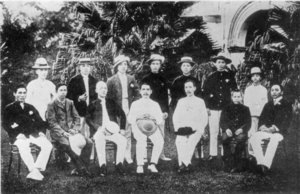
Tongmenghui
Sun Yat-sen successfully united the Revive China Society, Huaxinghui and Guangfuhui in the summer of 1905, thereby establishing the unified Tongmenghui (United League) in August 1905 in Tokyo.[17] While it started in Tokyo, it had loose organizations distributed across and outside the country. Sun Yat-sen was the leader of this unified group. Other revolutionaries who worked with the Tongmenghui include Wang Jingwei and Hu Hanmin. When the Tongmenhui was established, more than 90% of the Tongmenhui members were between 17–26 years of age.[18] Some of the work in the era includes manhua publications, such as the Journal of Current Pictorial.[19]
Later groups
In February 1906 Rizhihui (日知會) also had many revolutionaries, including Sun Wu (孫武), Zhang Nanxian (張難先), He Jiwei and Feng Mumin.[20][21] A nucleus of attendees of this conference evolved into the Tongmenhui's establishment in Hubei.
In July 1907 several members of Tongmenhui in Tokyo advocated a revolution in the area of the Yangtze River. Liu Quiyi (劉揆一), Jiao Dafeng (焦達峰), Zhang Boxiang (張伯祥) and Sun Wu (孫武) established Gongjinhui (Progressive Association) (共進會).[22][23] In January 1911, the revolutionary group Zhengwu Xueshe (振武學社) was renamed as Wenxueshe (Literary society) (文學社).[24] Jiang Yiwu (蔣翊武) was chosen as the leader.[25] These two organizations would play a big role in the Wuchang Uprising.
Many young revolutionaries adopted the radical programs of the anarchists. In Tokyo Liu Shipei proposed the overthrow of the Manchus and a return to Chinese classical values. In Paris Li Shizhen, Wu Zhihui and Zhang Renjie agreed with Sun on the necessity of revolution and joined the Tongmenghui, but argued that a political replacement of one government with another government would not be progress; revolution in family, gender and social values would remove the need for government and coercion. Zhang Ji was among the anarchists who defended assassination and terrorism as a means toward revolution, but others insisted that only education was justifiable. Important anarchists included Cai Yuanpei, Wang Jingwei and Zhang Renjie, who gave Sun major financial help. Many of these anarchists would later assume high positions in the Kuomintang (KMT).[26]
Views
Many revolutionaries promoted anti-Qing/anti-Manchu sentiments and revived memories of conflict between the ethnic minority Manchu and the ethnic majority Han Chinese from the late Ming dynasty (1368–1644). Leading intellectuals were influenced by books that had survived from the last years of the Ming dynasty, the last dynasty of Han Chinese. In 1904, Sun Yat-sen announced that his organization's goal was "to expel the Tatar barbarians, to revive Zhonghua, to establish a Republic, and to distribute land equally among the people." (驅除韃虜, 恢復中華, 創立民國, 平均地權).[17] Many of the underground groups promoted the ideas of "Resist Qing and restore Ming" (反清復明) that had been around since the days of the Taiping Rebellion.[27] Others, such as Zhang Binglin, supported straight-up lines like "slay the manchus" and concepts like "Anti-Manchuism" (興漢滅胡 / 排滿主義).[28]
Strata and groups
The Xinhai Revolution was supported by many groups, including students and intellectuals who returned from abroad, as well as participants of the revolutionary organizations, overseas Chinese, soldiers of the new army, local gentry, farmers and others.
Overseas Chinese
Assistance from overseas Chinese was important in the Xinhai Revolution. In 1894, the first year of the Revive China Society, the first meeting ever held by the group was held in the home of Ho Fon, an overseas Chinese who was the leader of the first Chinese Church of Christ.[29] Overseas Chinese supported and actively participated in the funding of revolutionary activities, especially the Southeast Asia Chinese of Malaya (Singapore and Malaysia).[30] Many of these groups were reorganized by Sun, who was referred to as the "father of the Chinese revolution".[30]
Newly emerged intellectuals
In 1906, after the abolition of the imperial examinations, the Qing government established many new schools and encouraged students to study abroad. Many young people attended the new schools or went abroad to study in places like Japan.[31] A new class of intellectuals emerged from those students, who contributed immensely to the Xinhai Revolution. Besides Sun Yat-sen, key figures in the revolution, such as Huang Xing, Song Jiaoren, Hu Hanmin, Liao Zhongkai, Zhu Zhixin and Wang Jingwei, were all Chinese students in Japan. Some were young students like Zou Rong, known for writing the book Revolutionary Army, in which he talked about the extermination of the Manchus for the 260 years of oppression, sorrow, cruelty and tyranny and turning the sons and grandsons of Yellow Emperor into George Washingtons.[32]
Before 1908, revolutionaries focused on coordinating these organizations in preparation for uprisings that these organizations would launch; hence, these groups would provide most of the manpower needed for the overthrow of the Qing Dynasty. After the Xinhai Revolution, Sun Yat-sen recalled the days of recruiting support for the revolution and said, "The literati were deeply into the search for honors and profits, so they were regarded as having only secondary importance. By contrast, organizations like Sanhehui were able to sow widely the ideas of resisting the Qing and restoring the Ming."[33]
Gentry and businessmen
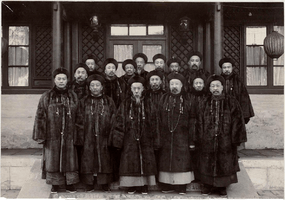
The strength of the gentry in local politics had become apparent. From December 1908, the Qing government created some apparatus to allow the gentry and businessmen to participate in politics. These middle-class people were originally supporters of constitutionalism. However, they became disenchanted when the Qing government created a cabinet with Prince Qing as prime minister.[34] By early 1911, an experimental cabinet had thirteen members, nine of whom were Manchus selected from the imperial family.[35]
Foreigners
Besides Chinese and overseas Chinese, some of the supporters and participants of the Xinhai Revolution were foreigners; among them, the Japanese were the most active group. Some Japanese even became members of Tongmenghui. Miyazaki Touten was the closest Japanese supporter; others included Heiyama Shu and Ryōhei Uchida. Homer Lea, an American, who became Sun Yat-sen's closest foreign advisor in 1910, supported Sun Yat-sen's military ambitions.[36] British soldier Rowland J. Mulkern also took part in the revolution.[37] Some foreigners, such as English explorer Arthur de Carle Sowerby, led expeditions to rescue foreign missionaries in 1911 and 1912.[38]
The far right wing Japanese ultra-nationalist Black Dragon Society supported Sun Yat-sen's activities against the Manchus, believing that overthrowing the Qing would help the Japanese take over the Manchu homeland and that Han Chinese would not oppose the take over. Toyama believed that the Japanese could easily take over Manchuria and Sun Yat-sen and other anti-Qing revolutionaries would not resist and help the Japanese take over and enlargen the opium trade in China while the Qing was trying to destroy the opium trade. The Japanese Black Dragons supported Sun Yat-sen and anti-Manchu revolutionaries until the Qing collapsed.[39] The far right wing Japanese ultranationalist Gen'yōsha leader Tōyama Mitsuru supported anti-Manchu, anti-Qing revolutionary activities including by Sun Yat-sen and supported Japanese taking over Manchuria. The anti-Qing Tongmenghui was founded and based in exile in Japan where many anti-Qing revolutionaries gathered.
The Japanese had been trying to unite anti-Manchu groups made out of Han people to take down the Qing. Japanese were the ones who helped Sun Yat-sen unite all anti-Qing, anti-Manchu revolutionary groups together and there were Japanese like Tōten Miyazaki inside of the anti-Manchu Tongmenghui revolutionary alliance. The Black Dragon Society hosted the Tongmenghui in its first meeting.[40] The Black Dragon Society had very intimate relations with Sun Yat-sen and promoted pan-Asianism and Sun sometimes passed himself off as Japanese.[41] That had connections with Sun for a long time.[42] Japanese groups like the Black Dragon Society had a large impact on Sun Yat-sen.[43] According to an American military historian, Japanese military officers were part of the Black Dragon Society. The Yakuza and Black Dragon Society helped arrange in Tokyo for Sun Yat-sen to hold the first Kuomintang meetings, and were hoping to flood China with opium and overthrow the Qing and deceive Chinese into overthrowing the Qing to Japan's benefit. After the revolution was successful, the Japanese Black Dragons started infiltrating China and spreading opium. The Black Dragons pushed for the takeover of Manchuria by Japan in 1932.[44] Sun Yat-sen was married to a Japanese, Kaoru Otsuki.
Soldiers of the new armies
The New Army was formed in 1901 after the defeat of the Qings in the First Sino-Japanese War.[31] They were launched by a decree from eight provinces.[31] New Army troops were by far the best trained and equipped.[31] The recruits were of a higher quality than the old army and received regular promotions.[31] Beginning in 1908, the revolutionaries began to shift their call to the new armies. Sun Yat-sen and the revolutionaries infiltrated the New Army.[45]
Uprisings and incidents
The central focus of the uprisings were mostly connected with the Tongmenghui and Sun Yat-sen, including subgroups. Some uprisings involved groups that never merged with the Tongmenghui. Sun Yat-sen may have participated in 8–10 uprisings; all uprisings prior to the failed Wuchang Uprising.
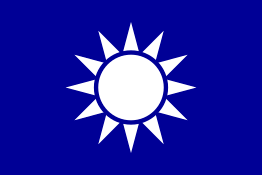
First Guangzhou Uprising
In the spring of 1895, the Revive China Society, which was based in Hong Kong, planned the First Guangzhou Uprising (廣州起義). Lu Haodong was tasked with designing the revolutionaries' Blue Sky with a White Sun flag.[30] On 26 October 1895, Yeung Ku-wan and Sun Yat-sen led Zheng Shiliang and Lu Haodong to Guangzhou, preparing to capture Guangzhou in one strike. However, the details of their plans were leaked to the Qing government.[46] The government began to arrest revolutionaries, including Lu Haodong, who was later executed.[46] The first Guangzhou uprising was a failure. Under pressure from the Qing government, the government of Hong Kong forbade these two men to enter the territory for five years. Sun Yat-sen went into exile, promoting the Chinese revolution and raising funds in Japan, the United States, Canada and Britain. In 1901, following the Huizhou uprising, Yeung Ku-wan was assassinated by Qing agents in Hong Kong.[47] After his death, his family protected his identity by not putting his name on his tomb, just a number: 6348.[47]
Independence Army Uprising
In 1901, after the Boxer Rebellion started, Tang Caichang (唐才常) and Tan Sitong of the previous Foot Emancipation Society organised the Independence Army. The Independence Army Uprising (自立軍起義) was planned to occur on 23 August 1900.[48] Their goal was to overthrow Empress Dowager Cixi to establish a constitutional monarchy under the Guangxu Emperor. Their plot was discovered by the governor general of Hunan and Hubei. About twenty conspirators were arrested and executed.[48]
Huizhou Uprising
On 8 October 1900, Sun Yat-sen ordered the launch of the Huizhou Uprising (惠州起義).[49] The revolutionary army was led by Zheng Shiliang and initially included 20,000 men, who fought for half a month. However, after the Japanese Prime Minister prohibited Sun Yat-sen from carrying out revolutionary activities on Taiwan, Zheng Shiliang had no choice but to order the army to disperse. This uprising therefore also failed. British soldier Rowland J. Mulkern participated in this uprising.[37]
Great Ming Uprising
A very short uprising occurred from 25 to 28 January 1903, to establish a "Great Ming Heavenly kingdom" (大明順天國).[50] This involved Tse Tsan-tai, Li Jitang (李紀堂), Liang Muguang (梁慕光) and Hong Quanfu (洪全福), who formerly took part in the Jintian uprising during the Taiping Heavenly Kingdom era.[51]
Ping-liu-li Uprising
Ma Fuyi (馬福益) and Huaxinghui was involved in an uprising in the three areas of Pingxiang, Liuyang and Liling, called "Ping-liu-li Uprising", (萍瀏醴起義) in 1905.[52] The uprising recruited miners as early as 1903 to rise against the Qing ruling class. After the uprising failed, Ma Fuyi was executed.[52]
Beijing Zhengyangmen East Railway assassination attempt
Wu Yue (吳樾) of Guangfuhui carried out an assassination attempt at the Beijing Zhengyangmen East Railway station (正陽門車站) in an attack on five Qing officials on 24 September 1905.[12][53]
Huanggang Uprising
The Huanggang Uprising (黃岡起義) was launched on 22 May 1907, in Chaozhou.[54] The Revolutionary party, along with Xu Xueqiu (許雪秋), Chen Yongpo (陳湧波) and Yu Tongshi (余通實), launched the uprising and captured Huanggang city.[54] Other Japanese that followed include (萱野長知) and (池亨吉).[54] After the uprising began, the Qing government quickly and forcefully suppressed it. Around 200 revolutionaries were killed.[55]
Huizhou Qinühu Uprising
In the same year, Sun Yat-sen sent more revolutionaries to Huizhou to launch the "Huizhou Qinühu Uprising" (惠州七女湖起義).
[56] On 2 June, Deng Zhiyu (鄧子瑜) and Chen Chuan (陳純) gathered some followers, and together, they seized Qing arms in the lake, 20 km (12 mi) from Huizhou.[57] They killed several Qing soldiers and attacked Taiwei (泰尾) on 5 June.[57] The Qing army fled in disorder, and the revolutionaries exploited the opportunity, capturing several towns. They defeated the Qing army once again in Bazhiyie. Many organizations voiced their support after the uprising, and the number of revolutionary forces increased to two hundred men at its height. The uprising, however, ultimately failed.
Anqing Uprising
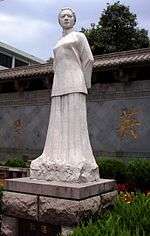
On 6 July 1907, Xu Xilin of Guangfuhui led an uprising in Anqing, Anhui, which became known as the Anqing Uprising (安慶起義).[24] Xu Xilin at the time was the police commissioner as well as the supervisor of the police academy. He led an uprising that was to assassinate the provincial governor of Anhui, En Ming (恩銘).[58] They were defeated after four hours of fighting. Xu was captured, and En Ming's bodyguards cut out his heart and liver and ate them.[58] His cousin Qiu Jin was executed a few days later.[58]
Qinzhou Uprising
From August to September 1907, the Qinzhou Uprising occurred (欽州防城起義).,[59] to protest against heavy taxation from the government. Sun Yat-sen sent Wang Heshun (王和順) there to assist the revolutionary army and captured the county in September.[60] After that, they attempted to besiege and capture Qinzhou, but they were unsuccessful. They eventually retreated to the area of Shiwandashan, while Wang Heshun returned to Vietnam.
Zhennanguan Uprising
On 1 December 1907, the Zhennanguan Uprising (鎮南關起事) took place at Zhennanguan, a pass on the Chinese-Vietnamese border. Sun Yat-sen sent Huang Mintang (黃明堂) to monitor the pass, which was guarded by a fort.[60] With the assistance of supporters among the fort's defenders, the revolutionaries captured the cannon tower in Zhennanguan. Sun Yat-sen, Huang Xing and Hu Hanmin personally went to the tower to command the battle.[61] The Qing government sent troops led by Long Jiguang and Lu Rongting to counterattack, and the revolutionaries were forced to retreat into the mountainous areas. After the failure of this uprising, Sun was forced to move to Singapore due to anti-Sun sentiments within the revolutionary groups.[62] He would not return to the mainland until after the Wuchang Uprising.
Qin-lian Uprising
On 27 March 1908, Huang Xing launched a raid, later known as the Qin-lian Uprising (欽廉上思起義), from a base in Vietnam and attacked the cities of Qinzhou and Lianzhou in Guangdong. The struggle continued for fourteen days but was forced to terminate after the revolutionaries ran out of supplies.[63]
Hekou Uprising
In April 1908, another uprising was launched in Yunnan, Hekou, called the Hekou Uprising (雲南河口起義). Huang Mingtang (黃明堂) led two hundred men from Vietnam and attacked Hekou on 30 April. Other revolutionaries who participated include Wang Heshun (王和順) and Guan Renfu (關仁甫). They were outnumbered and defeated by government troops, however, and the uprising failed.[64]
Mapaoying Uprising
On 19 November 1908, the Mapaoying Uprising (馬炮營起義) was launched by revolutionary group Yuewanghui (岳王會) member Xiong Chenggei (熊成基) at Anhui.[65] Yuewanghui, at this time, was a subset of Tongmenghui. This uprising also failed.
Gengxu New Army Uprising
In February 1910, the Gengxu New Army Uprising (庚戌新軍起義), also known as the Guangzhou New Army Uprising (廣州新軍起義), took place.[66] This involved a conflict between the citizens and local police against the New Army. After revolutionary leader Ni Yingdian was killed by Qing forces, the remaining revolutionaries were quickly defeated, causing the uprising to fail.
Second Guangzhou Uprising
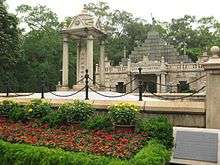
On 27 April 1911, an uprising occurred in Guangzhou, known as the Second Guangzhou Uprising (辛亥廣州起義) or Yellow Flower Mound Revolt (黃花岡之役). It ended in disaster, as 86 bodies were found (only 72 could be identified).[67] The 72 revolutionaries were remembered as martyrs.[67] Revolutionary Lin Juemin (林覺民) was one of the 72. On the eve of battle, he wrote the legendary "A Letter to My Wife" (與妻訣別書), later to be considered as a masterpiece in Chinese literature.[68] [69]
Wuchang Uprising
_18_dots.svg.png)
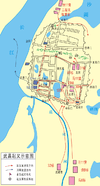
The Literary Society (文學社) and the Progressive Association (共進會) were revolutionary organizations involved in the uprising that mainly began with a Railway Protection Movement protest.[23] In the late summer, some Hubei New Army units were ordered to neighboring Sichuan to quell the Railway Protection Movement, a mass protest against the Qing government's seizure and handover of local railway development ventures to foreign powers.[70] Banner officers like Duanfang, the railroad superintendent,[71] and Zhao Erfeng led the New Army against the Railway Protection Movement.
The New Army units of Hubei had originally been the Hubei Army, which had been trained by Qing official Zhang Zhidong.[2] On 24 September, the Literary Society and Progressive Association convened a conference in Wuchang, along with sixty representatives from local New Army units. During the conference, they established a headquarters for the uprising. The leaders of the two organizations, Jiang Yiwu (蔣翊武) and Sun Wu (孫武), were elected as commander and chief of staff. Initially, the date of the uprising was to be 6 October 1911.[72] It was postponed to a later date due to insufficient preparations.
Revolutionaries intent on overthrowing the Qing dynasty had built bombs, and on 9 October, one accidentally exploded.[72] Sun Yat-sen himself had no direct part in the uprising and was traveling in the United States at the time in an effort to recruit more support from among overseas Chinese. The Qing Viceroy of Huguang, Rui Cheng (瑞澂), tried to track down and arrest the revolutionaries.[73] Squad leader Xiong Bingkun (熊秉坤) and others decided not to delay the uprising any longer and launched the revolt on 10 October 1911, at 7 pm.[73] The revolt was a success; the entire city of Wuchang was captured by the revolutionaries on the morning of 11 October. That evening, they established a tactical headquarters and announced the establishment of the "Military Government of Hubei of Republic of China".[73] The conference chose Li Yuanhong as the governor of the temporary government.[73] Qing officers like the bannermen Duanfang and Zhao Erfeng were killed by the revolutionary forces.
Provincial Uprisings
After the success of the Wuchang Uprising, many other protests occurred throughout the country for various reasons. Some of the uprisings declared restoration (光復) of the Han Chinese rule. Other uprisings were a step toward independence, and some were protests or rebellions against the local authorities. Regardless the reason for the uprising the outcome was that all provinces in the country renounced the Qing dynasty and joined the ROC.
Changsha restoration
On 22 October 1911, the Hunan Tongmenghui were led by Jiao Dafeng (焦達嶧) and Chen Zuoxin (陳作新).[74] They headed an armed group, consisting partly of revolutionaries from Hongjiang and partly of defecting New Army units, in a campaign to extend the uprising into Changsha.[74] They captured the city and killed the local Imperial general. Then they announced the establishment of the Hunan Military Government of the Republic of China and announced their opposition to the Qing Empire.[74]
Shaanxi Uprising
On the same day, Shaanxi's Tongmenghui, led by Jing Dingcheng (景定成) and Qian ding (錢鼎) as well as Jing Wumu (井勿幕) and others including Gelaohui, launched an uprising and captured Xi'an after two days of struggle.[75] The Muslim general Ma Anliang led more than twenty battalions of Hui Muslim troops to defend the Qing imperials and attacked Shaanxi, held by revolutionary Zhang Fenghui (張鳳翽).[76] The attack was successful, but after news arrived that Puyi was about to abdicate, Ma agreed to join the new Republic.[76] The revolutionaries established the "Qinlong Fuhan Military Government" and elected Zhang Fenghui, a member of the Yuanrizhi Society (原日知會), as new governor.[75] Xi'an Manchu city (滿城) finally fell on 24 October, after a massacre of 20,000 Manchus in living there.[77][78] Many of its Manchu defenders committed suicide, including Qing general Wenrui (文瑞), who threw himself down a well.[77]
Jiujiang Uprising
On 23 October, Lin Sen, Jiang Qun (蔣群), Cai Hui (蔡蕙) and other members of the Tongmenghui in the province of Jiangxi plotted a revolt of New Army units.[74][79] After they achieved victory, they announced their independence. The Jiujiang Military Government was then established.[79]
Shanxi Taiyuan Uprising
On 29 October, Yan Xishan of the New Army led an uprising in Taiyuan, the capital city of the province of Shanxi, along with Yao Yijie (姚以價), Huang Guoliang (黃國梁), Wen Shouquan (溫壽泉), Li Chenglin (李成林), Zhang Shuzhi (張樹幟) and Qiao Xi (喬煦).[79][80] They managed to kill the Qing Governor of Shanxi, Lu Zhongqi (陸鍾琦).[81] They then announced the establishment of Shanxi Military Government with Yan Xishan as the military governor.[75] Yan Xishan would later become one of the warlords that plagued China during what was known as "the warlord era".
Kunming Double Ninth Uprising
On 30 October, Li Genyuan (李根源) of the Tongmenghui in Yunnan joined with Cai E, Luo Peijin (羅佩金), Tang Jiyao, and other officers of the New Army to launch the Double Ninth Uprising (重九起義).[82] They captured Kunming the next day and established the Yunnan Military Government, electing Cai E as the military governor.[79]
Nanchang restoration
On 31 October, the Nanchang branch of the Tongmenghui led New Army units in a successful uprising. They established the Jiangxi Military Government.[74] Li Liejun was elected as the military governor.[79] Li declared Jiangxi as independent and launched an expedition against Qing official Yuan Shikai.[68]
Shanghai Armed Uprising
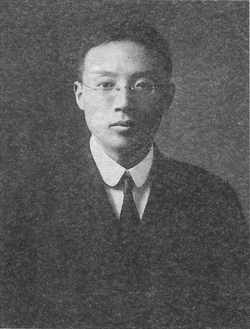
On 3 November, Shanghai's Tongmenghui, Guangfuhui and merchants led by Chen Qimei (陳其美), Li Pingsu (李平書), Zhang Chengyou (張承槱), Li Yingshi (李英石), Li Xiehe (李燮和) and Song Jiaoren organized an armed rebellion in Shanghai.[79] They received the support of local police officers.[79] The rebels captured the Jiangnan Workshop on the 4th and captured Shanghai soon after. On 8 November, they established the Shanghai Military Government and elected Chen Qimei as the military governor.[79] He would eventually become one of the founders of the ROC four big families, along with some of the most well-known families of the era.[83]
Guizhou Uprising
On 4 November, Zhang Bailin (張百麟) of the revolutionary party in Guizhou led an uprising along with New Army units and students from the military academy. They immediately captured Guiyang and established the Great Han Guizhou Military Government, electing Yang Jincheng (楊藎誠) and Zhao Dequan (趙德全) as the chief and vice governor.[84]
Zhejiang Uprising
Also on 4 November, revolutionaries in Zhejiang urged the New Army units in Hangzhou to launch an uprising.[79] Zhu Rui (朱瑞), Wu Siyu (吳思豫), Lu Gongwang (吕公望) and others of the New Army captured the military supplies workshop.[79] Other units, led by Chiang Kai-shek and Yin Zhirei (尹銳志), captured most of the government offices.[79] Eventually, Hangzhou was under the control of the revolutionaries, and the constitutionist Tang Shouqian (湯壽潛) was elected as the military governor.[79]
Jiangsu restoration
On 5 November, Jiangsu constitutionists and gentry urged Qing governor Cheng Dequan (程德全) to announce independence and established the Jiangsu Revolutionary Military Government with Cheng himself as the governor.[79][85] Unlike some of the other cities, anti-Manchu violence began after the restoration on 7 November in Zhenjiang.[86] Qing general Zaimu (載穆) agreed to surrender, but because of a misunderstanding, the revolutionaries were unaware that their safety was guaranteed.[86] The Manchu quarters were ransacked, and an unknown number of Manchus were killed.[86] Zaimu, feeling betrayed, committed suicide.[86] This is regarded as the Zhenjiang Uprising (鎮江起義).[87][88]
Anhui Uprising
Members of Anhui's Tongmenghui also launched an uprising on that day and laid siege to the provincial capital. The constitutionists persuaded Zhu Jiabao (朱家寶), the Qing Governor of Anhui, to announce independence.[89]
Guangxi Uprising
On 7 November, the Guangxi politics department decided to secede from the Qing government, announcing Guangxi's independence. Qing Governor Shen Bingkun (沈秉堃) was allowed to remain governor, but Lu Rongting would soon become the new governor.[60] Lu Rongting would later rise to prominence during the "warlord era" as one of the warlords, and his bandits controlled Guangxi for more than a decade.[90] Under the leadership of Huang Shaohong, the Muslim law student Bai Chongxi enlisted in a Dare to Die unit to fight as a revolutionary.[91]
Fujian independence
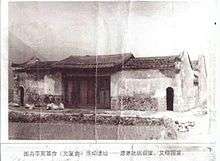
In November, members of Fujian's branch of the Tongmenghui, along with Sun Daoren (孫道仁) of the New Army, launched an uprising against the Qing army.[92][93] The Qing viceroy, Song Shou (松壽), committed suicide.[94] On 11 November, the entire Fujian province declared independence.[92] The Fujian Military Government was established, and Sun Daoren was elected as the military governor.[92]
Guangdong independence
Near the end of October, Chen Jiongming, Deng Keng (鄧鏗), Peng Reihai (彭瑞海) and other members of Guangdong's Tongmenghui organized local militias to launch the uprising in Huazhou, Nanhai, Sunde and Sanshui in Guangdong Province.[75][95] On 8 November, after being persuaded by Hu Hanmin, General Li Zhun (李準) and Long Jiguang (龍濟光) of the Guangdong Navy agreed to support the revolution.[75] The Qing viceroy of Liangguang, Zhang Mingqi (張鳴岐), was forced to discuss with the local representatives a proposal for Guangdong's independence.[75] They decided to announce it the next day. Chen Jiongming then captured Huizhou. On 9 November, Guangdong announced its independence and established a military government.[96] They elected Hu Hanmin and Chen Jiongming as the chief and vice governor.[97] Qiu Fengjia is known to have helped make the independence declaration more peaceful.[96] It was unknown at the time if representatives from the European colonies of Hong Kong and Macau would be ceded to the new government.
Shandong independence
On 13 November, persuaded by revolutionary Din Weifen (丁惟汾) and several other officers of the New Army, the Qing governor of Shandong, Sun Baoqi, agreed to secede from the Qing government and announced Shandong's independence.[75]
Ningxia Uprising
On 17 November, Ningxia the Tongmenghui launched the Ningxia Uprising (寧夏會黨起義). The revolutionaries sent Yu Youren to Zhangjiachuan to meet Dungan Sufi master Ma Yuanzhang to persuade him not to support the Qing. However, Ma did not want to endanger his relationship with the Qings. He sent the eastern Gansu Muslim militia under the command of one of his sons to help Ma Qi crush the Ningxia Gelaohui.[98][99] The Ningxia Revolutionary Military Government was established on 23 November.[75] Some of the revolutionaries involved included Huang Yue (黃鉞) and Xiang Shen (向燊), who gathered New Army forces at Qinzhou (秦州).[100][101]
Sichuan independence
On 21 November, Guang'an organized the Great Han Shu northern Military Government.[75][102]
On 22 November, Chengdu and Sichuan began to declare independence. By the 27th, the Great Han Sichuan Military Government was established, headed by revolutionary Pu Dianzun (蒲殿俊).[75] Qing official Duan Fang (端方) would also be killed.[75]
Nanking Uprising
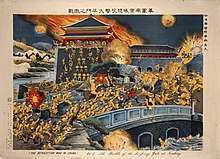
On 8 November, supported by the Tongmenghui, Xu Shaozhen (徐紹楨) of the New Army announced an uprising in Molin Pass (秣陵關), 30 km (19 mi) away from Nanking City.[75] Xu Shaozhen, Chen Qimei and other generals decided to form a united army under Xu to strike Nanking together. On 11 November, the united army headquarters was established in Zhenjiang. Between 24 November and 1 December, under the command of Xu Shaozhen, the united army captured Wulongshan (烏龍山), Mufushan (幕府山), Yuhuatai (雨花臺), Tianbao City (天保城) and many other strongholds of the Qing army.[75] On 2 December, Nanking City was captured by the revolutionaries after the Battle of Nanking, 1911.[75] On 3 December, revolutionary Su Liangbi led troops in a massacre of a large number of Manchus (the exact number is not known).[103] He was shortly afterward arrested, and his troops disbanded.[103]
Tibetan independence
In 1905, the Qing sent Zhao Erfeng to Tibet to retaliate against rebellions.[104] By 1908, Zhao was appointed imperial resident in Lhasa.[104] Zhao was beheaded in December 1911 by pro-Republican forces.[105] The bulk of the area that was historically known as Kham was now claimed to be the Xikang Administrative District, created by the Republican revolutionaries.[106] By the end of 1912, the last Manchu troops were forced out of Tibet through India. Thubten Gyatso, the 13th Dalai Lama, returned to Tibet in January 1913 from Sikkim, where he had been residing.[107] When the new ROC government apologised for the actions of the Qing and offered to restore the Dalai Lama to his former position, he replied that he was not interested in Chinese ranks, that Tibet had never been subordinated to China, that Tibet was an independent country, and that he was assuming the spiritual and political leadership of Tibet.[107] Because of this, many have read this reply as a formal declaration of independence. The Chinese side ignored the response, and Tibet had thirty years free of interference from China.[107]
Mongolian independence
At the end of 1911, the Mongols took action with an armed revolt against the Manchu authorities but were unsuccessful in the attempt.[108] An independence movement took place that was not limited to just North (outer) Mongolia but was a pan-Mongolian phenomenon.[108] On 29 December 1911, Bogd Khan became the leader of the Mongol empire. Inner Mongolia became a contested terrain between Khan and the Republic.[109] In general, Russia supported the Independence of Outer Mongolia (including Tannu Uriankhai) during the time of the Xinhai Revolution.[110] Tibet and Mongolia then recognized each other in a treaty.
Dihua and Yili Uprising
In Xinjiang on 28 December, Liu Xianzun (劉先俊) and the revolutionaries started the Dihua Uprising (迪化起義).[111] This was led by more than 100 members of Geilaohui.[112] This uprising failed. On 7 January 1912, the Yili Uprising (伊犁起義) with Feng Temin (馮特民) began.[111][112] Qing governor Yuan Dahua (袁大化) fled and handed over his resignation to Yang Zengxin, because he could not handle fighting the revolutionaries.[113]
In the morning of 8 January, a new Yili government was established for the revolutionaries,[112] but the revolutionaries would be defeated at Jinghe in January and February.[113][114] Eventually because of the abdication to come, Yuan Shikai recognized Yang Zengxin's rule, appointed him Governor of Xinjiang and had the province join the Republic.[113] Eleven more former Qing officials would be assassinated in Zhenxi, Karashahr, Aksu, Kucha, Luntai and Kashgar in April and May 1912.[113]
The revolutionaries printed new multi-lingual media.[115]
Taiwan Uprising
In 1911 as part of the Xinhai Revolution, Tongmenghui sent Luo Fu-xing (羅福星) to the island of Taiwan to free it from being occupied by the Japanese.[116] The goal was to bring Taiwan island back to the Chinese Republic by having the Taiwan Uprising (台灣起義).[117] Luo was caught and killed on 3 March 1914.[118] What was left was known as the "Miaoli incident", (苗栗事件) where more than 1,000 Taiwanese were executed by the Japanese police.[119] Luo's sacrifice is commemorated in Miaoli.[118]
Change of government

North: Qing court last transformation attempt
On 1 November 1911, the Qing government appointed Yuan Shikai as the prime minister of the imperial cabinet, replacing Prince Qing.[120] On 3 November, after a proposition by Cen Chunxuan from the Constitutional Monarchy Movement (立憲運動), in 1903, the Qing court passed the Nineteen Articles (憲法重大信條十九條), which turned the Qing from an autocratic system with the emperor having unlimited power to a constitutional monarchy.[121][122] On 9 November, Huang Xing even cabled Yuan Shikai and invited him to join the Republic.[123] The court changes were too late, and the emperor was about to have to step down.
South: Government in Nanking
On 28 November 1911, Wuchang and Hanyang had fallen back to the Qing army. So for safety, the revolutionaries convened their first conference at the British concession in Hankou on 30 November.[124] By 2 December, the revolutionary forces were able to capture Nanking in the uprising; the revolutionaries decided to make it the site of the new provisional government.[125] At the time, Beijing was still the Qing capital.
North–South Conference
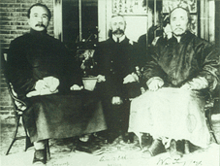
On 18 December, the North–South Conference (南北議和) was held in Shanghai to discuss the north and south issues.[126] Yuan Shikai selected Tang Shaoyi as his representative.[126] Tang left Beijing for Wuhan to negotiate with the revolutionaries.[126] The revolutionaries chose Wu Tingfang.[126] With the intervention of six foreign powers, the United Kingdom, the United States, Germany, Russia, Japan, and France, Tang Shaoyi and Wu Tingfang began to negotiate a settlement at the British concession.[127] Foreign businessman Edward Selby Little (李德立) acted as the negotiator and facilitated the peace agreement.[128] They agreed that Yuan Shikai would force the Qing emperor to abdicate in exchange for the southern provinces' support of Yuan as the president of the Republic. After considering the possibility that the new republic might be defeated in a civil war or by foreign invasion, Sun Yat-sen agreed to Yuan's proposal to unify China under Yuan Shikai's Beijing government. Further decisions were made to let the emperor rule over his little court in the New Summer Palace. He would be treated as a ruler of a separate country and have expenses of several million taels in silver.[129]
Establishment of the Republic
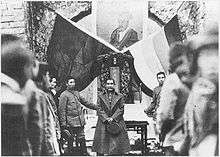
Republic of China declared and national flag issue
On 29 December 1911, Sun Yat-sen was elected as the first provisional president.[130] 1 January 1912, was set as the first day of the First Year of the ROC.[131] On 3 January, the representatives recommended Li Yuanhong as the provisional vice president.[132]
During and after the Xinhai Revolution, many groups that participated wanted their own pennant as the national flag. During the Wuchang Uprising, the military units of Wuchang wanted the nine-star flag with Taijitu.[133] Others in competition included Lu Haodong's Blue Sky with a White Sun flag. Huang Xing favored a flag bearing the mythical "well-field" system of village agriculture. In the end, the assembly compromised: the national flag would be the banner of Five Races Under One Union.[133] The Five Races Under One Union flag with horizontal stripes represented the five major nationalities of the republic.[134] The red represented Han, the yellow represented Manchus, the blue for Mongols, the white for Muslims, and the black for Tibetans.[133][134] Despite the general target of the uprisings to be the Manchus, Sun Yat-sen, Song Jiaoren and Huang Xing unanimously advocated racial integration to be carried out from the mainland to the frontiers.[135]
Donghuamen incident
On 16 January, while returning to his residence, Yuan Shikai was ambushed in a bomb attack organized by the Tongmenghui in Donghuamen (東華門), Beijing.[136] A total of eighteen revolutionaries were involved. About ten of the guards died, but Yuan himself was not seriously injured.[136] He sent a message to the revolutionaries the next day pledging his loyalty and asking them not to organize any more assassination attempts against him.
Abdication of the emperor
Zhang Jian drafted an abdication proposal that was approved by the Provisional Senate. On 20 January, Wu Tingfang of the Nanking Provisional government officially delivered the imperial edict of abdication to Yuan Shikai for the abdication of Puyi.[122] On 22 January, Sun Yat-sen announced that he would resign the presidency in favor of Yuan Shikai if the latter supported the emperor's abdication.[137] Yuan then pressured Empress Dowager Longyu with the threat that the lives of the imperial family would not be spared if abdication did not come before the revolutionaries reached Beijing, but if they agreed to abdicate, the provisional government would honor the terms proposed by the imperial family.
On 3 February, Empress Dowager Longyu gave Yuan full permission to negotiate the abdication terms of the Qing emperor. Yuan then drew up his own version and forwarded it to the revolutionaries on 3 February.[122] His version consisted of three sections instead of two.[122] On 12 February 1912, after being pressured by Yuan and other ministers, Puyi (age six) and Empress Dowager Longyu accepted Yuan's terms of abdication.[131]
Debate over the capital
As a condition for ceding leadership to Yuan Shikai, Sun Yat-sen insisted that the provisional government remain in Nanjing. On 14 February, the Provisional Senate initially voted 20–5 in favor of making Beijing the capital over Nanjing, with two votes going for Wuhan and one for Tianjin.[138] The Senate majority wanted to secure the peace agreement by taking power in Beijing.[138] Zhang Jian and others reasoned that having the capital in Beijing would check against Manchu restoration and Mongol secession. But Sun and Huang Xing argued in favor of Nanjing to balance against Yuan's power base in the north.[138] Li Yuanhong presented Wuhan as a compromise.[139] The next day, the Provisional Senate voted again, this time, 19-6 in favor of Nanjing with two votes for Wuhan.[138] Sun sent a delegation led by Cai Yuanpei and Wang Jingwei to persuade Yuan to move to Nanjing.[140] Yuan welcomed the delegation and agreed to accompany the delegates back to the south.[141] Then on the evening of 29 February, riots and fires broke out all over the city.[141] They were allegedly started by disobedient troops of Cao Kun, a loyal officer of Yuan.[141] The disorder gave Yuan the pretext to stay in the north to guard against unrest. On 10 March, Yuan was inaugurated in Beijing as the provisional president of the Republic of China.[142] On 5 April, the Provisional Senate in Nanjing voted to make Beijing the capital of the Republic and convened in Beijing at the end of the month.
Republican government in Beijing
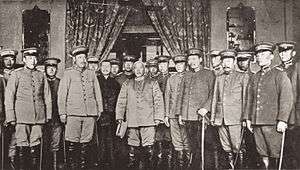
On 10 March 1912, Yuan Shikai was sworn as the second Provisional President of the Republic of China in Beijing.[143] The government based in Beijing, called the Beiyang Government, was not internationally recognized as the legitimate government of the Republic of China until 1928, so the period from 1912 until 1928 was known simply as the "Beiyang Period". The first National Assembly election took place according to the Provisional Constitution. While in Beijing, the Kuomintang was formed on 25 August 1912.[144] The KMT held the majority of seats after the election. Song Jiaoren was elected as premier. However, Song was assassinated in Shanghai on 20 March 1913, under the secret order of Yuan Shikai.[145]
Proposed Han monarchs and retention of aristocratic noble titles
Some advocated that a Han be installed as Emperor, either the descendant of Confucius, who was the Duke Yansheng,[146][147][148][149][150] or the Ming dynasty Imperial family descendant, the Marquis of Extended Grace.[151][152] The Duke Yansheng was proposed for replacing the Qing dynasty as Emperor by Liang Qichao.[153]
The Han hereditary aristocratic nobility like the Duke Yansheng, Marquis of Extended Grace, and the title of the Wujing Boshi (changed to "Dacheng Zhisheng Xianshi Nanzong Fengsi Guan" 大成至聖先師南宗奉祀官) and the titles held by the descendants of Mencius, Zengzi, and Yan Hui were retained by the new Republic of China and the title holders continued to receive their pensions.
Western views
The American Christian Rev. Dr. George F. Pentecost spoke out against western imperialism, saying:
As for the Chinese, I have the highest opinion not only of the Chinese character, but of the Chinese fitness for self-government. I think they are eminently fitted to make a republic successful. China, for instance, is infinitely better fitted than is Russia for development along republican lines. In fact, China has always been practically a republic. It has had its dynasties of rulers, but the political unit of China has always been the village. The village people have always had their influence upon the Government. What is more, the average Chinaman is intelligent.[154]
Legacy
Social influence
After the revolution, there was a huge outpouring of anti-Manchu sentiment through China, but particularly in Beijing where thousands died in anti-Manchu violence as Imperial restrictions on Han residency and behavior within the city crumbled as Manchu Imperial power crumbled.[155] Anti-Manchu sentiment is recorded in books like A Short History of Slaves (奴才小史) and The Biographies of Avaricious Officials and Corrupt Personnel (貪官污吏傳) by Laoli (老吏).[156][157]
During the abdication of the last emperor, Empress Dowager Longyu, Yuan Shikai and Sun Yat-sen both tried to adopt the concept of "Manchu and Han as one family" (滿漢一家).[156] People started exploring and debating with themselves on the root cause of their national weakness. This new search of identity was the New Culture Movement.[158] Manchu culture and language, on the contrary, has become virtually extinct by 2007.[159]
Unlike revolutions in the West, the Xinhai Revolution did not restructure society. The participants of the Xinhai Revolution were mostly military personnel, old-type bureaucrats, and local gentries. These people still held regional power after the Xinhai Revolution. Some became warlords. There were no major improvements in the standard of living. Writer Lu Xun commented in 1921 during the publishing of The True Story of Ah Q, ten years after the Xinhai Revolution, that basically nothing changed except "the Manchus have left the kitchen".[160] The economic problems were not addressed until the governance of Chiang Ching-kuo in Taiwan and Deng Xiaoping on the mainland.[161]
The Xinhai Revolution mainly got rid of feudalism (fengjian) from Late Imperial China. In the usual view of historians, there are two restorations of feudal power after the revolution: the first was Yuan Shikai; the second was Zhang Xun.[162] Both were unsuccessful, but the "feudal remnants" returned to China with the Cultural Revolution in a concept called guanxi, where people relied not on feudal relationships, but personal relationships, for survival.[163] While guanxi is helpful in Taiwan, on the mainland, guanxi is necessary to get anything done.[164]
Historical significance
The Xinhai Revolution overthrew the Qing government and two thousand years of monarchy.[2] Throughout Chinese history, old dynasties had always been replaced by new dynasties. The Xinhai Revolution, however, was the first to overthrow a monarchy completely and attempt to establish a republic to spread democratic ideas throughout China. Though in 1911 at the provisional government welcome ceremony, Sun Yat-sen said, "The revolution is not yet successful, the comrades still need to strive for the future." (革命尚未成功,同志仍需努力).[165]
Since the 1920s, the two dominant parties–the KMT and PRC–see the Xinhai Revolution quite differently.[166] Both sides recognize Sun Yat-sen as the Father of the Nation, but in Taiwan, they mean "Father of the Republic of China".[166] On the mainland, Sun Yat-sen was seen as the man who helped bring down the Qing, a pre-condition for the Communist state founded in 1949.[166] The PRC views Sun's work as the first step towards the real revolution in 1949, when the communists set up a truly independent state that expelled foreigners and built a military and industrial power.[166] The father of New China is seen as Mao Zedong.[166] In 1954, Liu Shaoqi was quoted as saying that the "Xinhai Revolution inserted the concept of a republic into common people".[167][168] Zhou Enlai pointed out that the "Xinhai Revolution overthrew the Qing rule, ended 2000 years of monarchy, and liberated the mind of people to a great extent, and opened up the path for the development of future revolution. This is a great victory."[169]
Modern evaluation
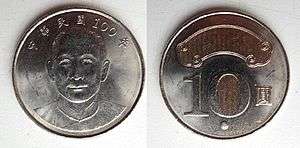
A change in the belief that the revolution had been a generally positive change began in the late 1980s and 1990s, but Zhang Shizhao was quoted as arguing that "When talking about the Xinhai Revolution, the theorist these days tends to overemphasize. The word 'success' was way overused."[170]
The success of the democracy gained from the revolution can vary depending on one's view. Even after the death of Sun Yat-sen in 1925, for sixty years, the KMT controlled all five branches of the government; none were independent.[161] Yan Jiaqi, founder of the Federation for a Democratic China, has said that Sun Yat-sen is to be credited as founding China's first republic in 1912, and the second republic is the people of Taiwan and the political parties there now democratizing the region.[162]
Meanwhile, the ideals of democracy are far from realised on the mainland. For example, former Chinese premier Wen Jiabao once said in a speech that without real democracy, there is no guarantee of economic and political rights; but he led a 2011 crackdown against the peaceful Chinese jasmine protests.[171] Liu Xiaobo, a pro-democracy activist who received the global 2010 Nobel Peace Prize, died in prison.[172] Others, such as Qin Yongmin (秦永敏) of the Democracy Party of China, who was only released from prison after twelve years, do not praise the Xinhai Revolution.[173][174] Qin Yongmin said the revolution only replaced one dictator with another, that Mao Zedong was not an emperor, but he is worse than the emperor.[173][174][175]
See also
Notes
^ a: Many of the Qing soldiers with Han background turned to support the revolution during the uprisings, so the actual casualties are hard to trace.
^ b: Clipping from Min Bao (People's Papers). Originally the publishing of Hua Xin Hui and named China of the Twentieth Century, it was renamed after the establishment of Tongmenhui.
References
- ↑ Li Xing. [2010] (2010). The Rise of China and the Capitalist World Order. Ashgate Publishing, Ltd. ISBN 0-7546-7913-6, ISBN 978-0-7546-7913-4. p. 91.
- 1 2 3 Li, Xiaobing. [2007] (2007). A History of the Modern Chinese Army. University Press of Kentucky. ISBN 0-8131-2438-7, ISBN 978-0-8131-2438-4. pg 13. pg 26–27.
- ↑ Wang, Gabe T. [2006] (2006). China and the Taiwan Issue: Impending War at Taiwan Strait. University Press of America. ISBN 0-7618-3434-6, ISBN 978-0-7618-3434-2. pg 91.
- 1 2 3 Wang, Ke-wen. [1998] (1998). Modern China: An Encyclopedia of History, Culture, and Nationalism. Taylor & Francis publishing. ISBN 0-8153-0720-9, ISBN 978-0-8153-0720-4. pg 106. pg 344.
- 1 2 Bevir, Mark. [2010] (2010). Encyclopedia of Political Theory. Sage Publishing. ISBN 1-4129-5865-2, ISBN 978-1-4129-5865-3. pg 168.
- ↑ Chang, Kang-i Sun, Owen, Stephen (2010). The Cambridge History of Chinese Literature, Volume 2. Cambridge University Press. ISBN 0-521-11677-5, ISBN 978-0-521-11677-0. pg 441.
- ↑ South China morning post. 29 March 2011. Hong Kong played a key role in the life of Sun Yat-sen.
- ↑ Lum, Yansheng Ma. Lum, Raymond Mun Kong. [1999] (1999). Sun Yat-sen in Hawaii: Activities and Supporters. University of Hawaii Press. ISBN 0-8248-2179-3, ISBN 978-0-8248-2179-1. pg 6–7
- ↑ Curthoys, Ann. Lake, Marilyn. [2005] (2005). Connected Worlds: History in Transnational Perspective. ANU Publishing. ISBN 1-920942-44-0, ISBN 978-1-920942-44-1. pg 101.
- ↑ Platt, Stephen R. [2007] (2007). Provincial Patriots: The Hunanese and Modern China. Harvard University Press. ISBN 0-674-02665-9, ISBN 978-0-674-02665-0. pg 128.
- ↑ Goossaert, Vincent. Palmer, David A. [2011] (2011). The Religious Question in Modern China. University of Chicago Press. ISBN 0-226-30416-7, ISBN 978-0-226-30416-8.
- 1 2 3 Wang, Ke-wen. [1998] (1998). Modern China: An Encyclopedia of History, Culture, and Nationalism. Taylor & Francis Publishing. ISBN 0-8153-0720-9, ISBN 978-0-8153-0720-4. pg 287.
- ↑ 中国人民大学. 书报资料中心. [1982] (1982). 中国近代史, Issues 1–6. 中国人民大学书报资料社 publishing. University of California Press.
- ↑ Chen, Lifu. Chang, Hsu-hsin. Myers, Ramon Hawley. [1994] (1994). The Storm Clouds Clear Over China: The Memoir of Chʻen Li-fu, 1900–1993. Hoover Press. ISBN 0-8179-9272-3, ISBN 978-0-8179-9272-9.
- ↑ João de Pina-Cabral. [2002] (2002). Between China and Europe: Person, Culture and Emotion in Macao. Berg Publishing. ISBN 0-8264-5749-5, ISBN 978-0-8264-5749-3. pg 209.
- ↑ 陳民, 中國社會科學院. 中華民國史研究室. [1981] (1981). 中國致公黨. 文史資料出版社. Digitized University of California 10 December 2007.
- 1 2 計秋楓, 朱慶葆. [2001] (2001). 中國近代史, V. 1. Chinese University Press. ISBN 962-201-987-0, ISBN 978-962-201-987-4. pg 468.
- ↑ Etō, Shinkichi. Schiffrin, Harold Z. [2008] (2008). China's Republican Revolution. University of Tokyo Press. Digitized 10 September 2008. ISBN 4-13-027030-3, ISBN 978-4-13-027030-4.
- ↑ Wong, Wendy Siuyi. [2002] (2001) Hong Kong Comics: A History of Manhua. Princeton Architectural Press. New York. ISBN 1-56898-269-0
- ↑ 为君丘, 張運宗. [2003] (2003). 走入近代中國. 五南圖書出版股份有限公司. ISBN 957-11-3175-X, 9789571131757.
- ↑ 蔣緯國. [1981] (1981). 建立民國, Volume 2. 國民革命戰史: 第1部. 黎明文化事業公司. University of California. Digitized 14 February 2011.
- ↑ 饒懷民. [2006] (2006). 辛亥革命與清末民初社會/中國近代史事論叢. 中華書局 publishing. ISBN 7-101-05156-1, ISBN 978-7-101-05156-8.
- 1 2 Wang, Ke-wen. [1998] (1998). Modern China: An Encyclopedia of History, Culture, and Nationalism. Taylor & Francis Publishing. ISBN 0-8153-0720-9, ISBN 978-0-8153-0720-4. pp. 390–391.
- 1 2 張豈之, 陳振江, 江沛. [2002] (2002). 晚淸民國史. Volume 5 of 中國歷史, 張 豈之. 五南圖書出版股份有限公司. ISBN 957-11-2898-8, ISBN 978-957-11-2898-6. pg 178–186
- ↑ 蔡登山. 繁華落盡──洋場才子與小報文人. 秀威資訊科技股份有限公司. ISBN 986-221-826-6, ISBN 978-986-221-826-6. pg 42.
- ↑ Scalapino, Robert A. and George T. Yu (1961). The Chinese Anarchist Movement. Berkeley: Center for Chinese Studies, Institute of International Studies, University of California. At The Anarchist Library (Free Download). The online version is unpaginated.
- ↑ 楊碧玉. 洪秀全政治人格之研究. 秀威資訊科技股份有限公司 Publishing. ISBN 986-221-141-5, ISBN 978-986-221-141-0.
- ↑ Crossley, Pamela Kyle. [1991] (1991). Orphan Warriors: Three Manchu Generations and the End of the Qing World. Princeton University Press. ISBN 0-691-00877-9, ISBN 978-0-691-00877-6. pg180-181.
- ↑ Lee, Khoon Choy Lee. [2005] (2005). Pioneers of Modern China: Understanding the Inscrutable Chinese. World Scientific. ISBN 981-256-618-X, 9789812566188.
- 1 2 3 Gao, James Zheng. [2009] (2009). Historical Dictionary of Modern China (1800–1949). Issue 25 of "Historical Dictionaries of Ancient Civilizations and Historical Eras". Scarecrow Press. ISBN 0-8108-4930-5, ISBN 978-0-8108-4930-3. pg 156. pg 29.
- 1 2 3 4 5 Fenby, Jonathan. [2008] (2008). The History of Modern China: The Fall and Rise of a Great Power. ISBN 978-0-7139-9832-0. pg 96. pg 106.
- ↑ Fenby, Jonathan. [2008] (2008). The History of Modern China: The Fall and Rise of a Great Power. ISBN 978-0-7139-9832-0. pg 109.
- ↑ Complete works of Sun Yat-sen 《總理全集》 First edition, page 920
- ↑ Rhoads, Edward J. M. [2000] (2000). Manchus & Han: Ethnic Relations and Political Power in Late Qing and Early Republican China, 1861–1928. University of Washington Press. ISBN 0-295-98040-0, ISBN 978-0-295-98040-9. pg21.
- ↑ Wang, Ke-wen. [1998] (1998). Modern China: An Encyclopedia of History, Culture, and Nationalism. Taylor & Francis Publishing. ISBN 0-8153-0720-9, ISBN 978-0-8153-0720-4. Pg 76.
- ↑ Kaplan, Lawrence M. (2010). Homer Lea American Soldier of Fortune. Lexington: University Press of Kentucky.
- 1 2 Lau, Kit-ching Chan. [1990] (1990). China, Britain and Hong Kong, 1895–1945. Chinese University Press. ISBN 962-201-409-7, ISBN 978-962-201-409-1. p. 37.
- ↑ Borst-Smith, Ernest F. (1912). Caught in the Chinese Revolution. T Fisher Unwin.
- ↑ Jay Robert Nash (1997-10-28). Spies: A Narrative Encyclopedia of Dirty Tricks and Double Dealing from Biblical Times to Today. M. Evans. pp. 99–. ISBN 978-1-4617-4770-3.
- ↑ Marie-Claire Bergère; Janet Lloyd (1998). Sun Yat-sen. Stanford University Press. pp. 132–. ISBN 978-0-8047-4011-1.
- ↑ Gerald Horne (2005-11). Race War!: White Supremacy and the Japanese Attack on the British Empire. NYU Press. pp. 252–. ISBN 978-0-8147-3641-8. Check date values in:
|date=(help) - ↑ Dooeum Chung (2000). Élitist fascism: Chiang Kaishek's Blueshirts in 1930s China. Ashgate. p. 61. ISBN 978-0-7546-1166-0.
- ↑ Dooeum Chung (1997). A re-evaluation of Chiang Kaishek's blueshirts: Chinese fascism in the 1930s. University of London. p. 78.
- ↑ Rodney Carlisle (2015-03-26). Encyclopedia of Intelligence and Counterintelligence. Routledge. pp. 71–. ISBN 978-1-317-47177-6.
- ↑ Spence, Jonathan D. [1990] (1990). The Search for Modern China. W. W. Norton & Company Publishing. ISBN 0-393-30780-8, ISBN 978-0-393-30780-1. pp. 250–256.
- 1 2 計秋楓, 朱慶葆. [2001] (2001). 中國近代史, Volume 1. Chinese University Press. ISBN 962-201-987-0, ISBN 978-962-201-987-4. p. 464.
- 1 2 South China morning post. 6 April 2011. Waiting may be over at grave of an unsung hero.
- 1 2 Wang, Ke-wen. [1998] (1998). Modern China: an encyclopedia of history, culture, and nationalism. Taylor & Francis Publishing. ISBN 0-8153-0720-9, ISBN 978-0-8153-0720-4. p. 424.
- ↑ Gao, James Zheng. [2009] (2009). Historical dictionary of modern China (1800–1949). Scarecrow Press. ISBN 0-8108-4930-5, ISBN 978-0-8108-4930-3. Chronology section.
- ↑ 陳錫祺. [1991] (1991). 孫中山年谱長編 volume 1. 中华书局. ISBN 7-101-00685-X, ISBN 9787101006858.
- ↑ 申友良. [2002] (2002). 报王黃世仲. 中囯社会科学出版社 publishing. ISBN 7-5004-3309-3, ISBN 978-7-5004-3309-5.
- 1 2 Joan Judge. [1996] (1996). Print and politics: 'Shibao' and the culture of reform in late Qing China. Stanford University Press. ISBN 0-8047-2741-4, ISBN 978-0-8047-2741-9. p. 214.
- ↑ 清宮藏辛亥革命檔案公佈 清廷密追孫中山(圖)-新聞中心_中華網. China.com (in Chinese). Retrieved 2011-10-16.
- 1 2 3 張家鳳. [2010] (2010). 中山先生與國際人士. Volume 1. 秀威資訊科技股份有限公司. ISBN 986-221-510-0, ISBN 978-986-221-510-4. p. 195.
- ↑ "宝鸡新闻网——荟集宝鸡新闻". Baojinews.com. 27 May 2011. Retrieved 2011-10-16.
- ↑ 張豈之, 陳振江, 江沛. [2002] (2002). 晚淸民國史. Volume 5 of 中國歷史. 五南圖書出版股份有限公司 publishing. ISBN 957-11-2898-8, ISBN 978-957-11-2898-6. p. 177.
- 1 2 中国二十世紀通鉴编辑委员会. [2002] (2002). 中国二十世紀通鉴, 1901–2000, Volume 1. 线装書局.
- 1 2 3 Lu Xun. Nadolny, Kevin John. [2009] (2009). Capturing Chinese: Short Stories from Lu Xun's Nahan. Capturing Chinese publishing. ISBN 0-9842762-0-3, ISBN 978-0-9842762-0-2. p. 51.
- ↑ 鄭連根. [2009] (2009). 故紙眉批── 一個傳媒人的讀史心得. 秀威資訊科技股份有限公司 publishing. ISBN 986-221-190-3, ISBN 978-986-221-190-8. p. 135.
- 1 2 3 辛亥革命武昌起義紀念館. [1991] (1991). 辛亥革命史地圖集. 中國地圖出版社 publishing.
- ↑ 中華民國史硏究室. [1986] (1986). 中華民國史資料叢稿: 譯稿. Volumes 1–2 of 中華民國史資料叢稿. published by 中華書局.
- ↑ Yan, Qinghuang. [2008] (2008). The Chinese in Southeast Asia and Beyond: Socioeconomic and Political Dimensions. World Scientific Publishing. ISBN 981-279-047-0, ISBN 978-981-279-047-7. pp. 182–187.
- ↑ 廣西壯族自治區地方誌編纂委員會. [1994] (1994). 廣西通志: 軍事志. 廣西人民出版社 publishing. Digitized University of Michigan. 26 October 2009.
- ↑ 中国百科年鉴. [1982] (1982). 中国大百科全书出版社. University of California. Digitized 18 December 2008.
- ↑ 汪贵胜, 许祖范. Compiled by 程必定. [1989] (1989). 安徽近代经济史. 黄山书社. Digitized by the University of Michigan. 31 October 2007.
- ↑ 张新民. [1993] (1993). 中国人权辞书. 海南出版社 publishing. Digitized by University of Michigan. 9 October 2009.
- 1 2 王恆偉. (2005) (2006) 中國歷史講堂 No. 5 清. 中華書局. ISBN 962-8885-28-6. p 195-198.
- 1 2 Langmead, Donald. [2011] (2011). Maya Lin: A Biography. ABC-CLIO Publishing. ISBN 0-313-37853-3, ISBN 978-0-313-37853-9. pp. 5–6.
- ↑ "Lin Jue Min's "Letter of Farewell to My Wife" — My translation". 15 November 2009.
- ↑ Reilly, Thomas. [1997] (1997). Science and Football III, Volume 3. Taylor & Francis publishing. ISBN 0-419-22160-3, ISBN 978-0-419-22160-9. pp. 105–106, 277–278.
- ↑ Robert H. Felsing (1979). The heritage of Han: the Gelaohui and the 1911 revolution in Sichuan. University of Iowa. p. 156. Retrieved 2012-03-02.
The railway company's chief officer at Yichang was no longer listening to company directives and had turned company accounts over to Duanfang, Superintendent of the Chuan Han and Yue Han railroads. The situation of the Sichuanese
- 1 2 王恆偉. (2005) (2006) 中國歷史講堂 No. 6 民國. 中華書局. ISBN 962-8885-29-4. pp. 3–7.
- 1 2 3 4 戴逸, 龔書鐸. [2002] (2003) 中國通史. 清. Intelligence Press. ISBN 962-8792-89-X. pp. 86–89.
- 1 2 3 4 5 张创新. [2005] (2005). 中国政治制度史. 2nd Edition. Tsinghua University Press. ISBN 7-302-10146-9, ISBN 978-7-302-10146-8. p. 377.
- 1 2 3 4 5 6 7 8 9 10 11 12 13 14 "武昌起義之後各省響應與國際調停 _新華網湖北頻道". xinhuanet.com. Retrieved 2011-10-16.
- 1 2 Jonathan Neaman Lipman (2004). Familiar Strangers: A History of Muslims in Northwest China. Seattle: University of Washington Press. p. 170. ISBN 0-295-97644-6. Retrieved 28 June 2010.
- 1 2 Rhoads, Edward J. M. [2000] (2000). Manchus & Han: Ethnic Relations and Political Power in Late Qing and Early Republican China, 1861–1928. University of Washington publishing. ISBN 0-295-98040-0, ISBN 978-0-295-98040-9. pg 192.
- ↑ Edward J. M. Rhoads (2000). Manchus and Han: Ethnic Relations and Political Power in Late Qing and Early Republican China, 1861–1928. University of Washington. p. 190.
- 1 2 3 4 5 6 7 8 9 10 11 12 13 伍立杨. [2011] (2011). 中国1911 (辛亥年). ISBN 978-7-5313-3869-7, ISBN 7-5313-3869-6. Chapter 连锁反应 各省独立.
- ↑ 蒋顺兴, 李良玉. [1990] (1990). 山西王阎锡山/中华民国史丛书. Edition reprint. 河南人民出版社, 1990.
- ↑ "山西辛亥革命官僚階層——巡撫陸鍾琦之死_辛亥革命前奏_辛亥革命网". Big5.xhgmw.org. Retrieved 2011-10-16.
- ↑ 中共湖南省委員會. [1981] (1981). 新湘評論, Issues 7–12. 新湘評論雜誌社.
- ↑ ""四大家族"后人:蒋家凋零落寞 宋、孔、陈家低调". Chinanews.com.cn. Retrieved 2011-10-16.
- ↑ 张玉法, 中央硏究院. 近代史硏究所. [1985] (1985). 民国初年的政党. 中央硏究院近代史硏究所 Publishing.
- ↑ "辛亥百年蘇州光復 一根竹竿挑瓦革命". Big5.xinhuanet.com. Retrieved 2011-10-16.
- 1 2 3 4 Rhoads, Edward J. M. [2000] (2000). Manchus & Han: Ethnic Relations and Political Power in Late Qing and Early Republican China, 1861–1928. University of Washington Press. ISBN 0-295-98040-0, ISBN 978-0-295-98040-9. pg 194.
- ↑ "辛亥革命大事記_時政頻道_新華網". Big5.xinhuanet.com. Retrieved 2011-11-17.
- ↑ http://www.xinhai.org/shi/191107129.htm
- ↑ 國立臺灣師範大學. 歷史學系. [2003] (2003). Bulletin of historical research, Issue 31. 國立臺灣師範大學歷史學系 publishing.
- ↑ Lary, Diana. [2010] (2010). Warlord Soldiers: Chinese Common Soldiers 1911–1937. Cambridge University Press. ISBN 0-521-13629-6, ISBN 978-0-521-13629-7. pg 64.
- ↑ Howard L. Boorman; Richard C. Howard; Joseph K. H. Cheng (1967). Biographical Dictionary of Republican China. Columbia University Press. pp. 51–. ISBN 978-0-231-08957-9.
- 1 2 3 国祁李. [1990] (1990). 民国史论集, Volume 2. 南天書局 publishing.
- ↑ [1979] (1979). 傳記文學, Volume 34. 傳記文學雜誌社 Publishing. University of Wisconsin – Madison. Digitized 11 April 2011.
- ↑ 鄧之誠. [1983] (1983). 中華二千年史, Volume 5, Part 3, Issue 1. 中華書局. ISBN 7-101-00390-7, ISBN 978-7-101-00390-1.
- ↑ 广东省中山图书馆. [2002] (2002). 民国广东大事记. 羊城晚报出版社 Publishing. ISBN 7-80651-206-3, ISBN 978-7-80651-206-7.
- 1 2 徐博东, 黄志萍. [1987] (1987). 丘逢甲傳. 秀威資訊科技股份有限公司 publishing. ISBN 986-221-636-0, ISBN 978-986-221-636-1. pg 175.
- ↑ 居正, 羅福惠, 蕭怡. [1989] (1989). 居正文集, Volume 1. 華中師範大學出版社 publishing. Digitized by University of California. 15 December 2008.
- ↑ Travels of a Consular Officer in North-West China. CUP Archive. p. 188. Retrieved 28 June 2010.
- ↑ Jonathan Neaman Lipman (2004). Familiar Strangers: A History of Muslims in Northwest China. Seattle: University of Washington Press. pp. 182, 183. ISBN 0-295-97644-6. Retrieved 28 June 2010.
- ↑ 粟戡时, 同明, 志盛, 雪云. [1981] (1981). 湖南反正追记. 湖南人民出版社.
- ↑ 辛亥革命史地圖集. [1991] (1991). 辛亥革命武昌起義紀念館. 中國地圖出版社.
- ↑ 中國地圖出版社. [1991] (1991). 辛亥革命史地圖集. 中國地圖出版社 publishing.
- 1 2 Rhoads, Edward J. M. [2000] (2000). Manchus & Han: Ethnic Relations and Political Power in Late Qing and Early Republican China, 1861–1928. University of Washington Publishing. ISBN 0-295-98040-0, ISBN 978-0-295-98040-9. pg 198.
- 1 2 Blondeau, Anne-Marie. Buffetrille, Katia. Jing, Wei. [2008] (2008). Authenticating Tibet: Answers to China's 100 Questions. University of California Press. ISBN 0-520-24464-8, ISBN 978-0-520-24464-1. pg 230.
- ↑ Grunfeld, A. Tom. [1996] (1996). The Making of Modern Tibet Edition 2. M.E. Sharpe Publishing. ISBN 1-56324-714-3, ISBN 978-1-56324-714-9. pg 63.
- ↑ Rong, Ma. [2010] (2010). Population and Society in Tibet. Hong Kong University Press. ISBN 962-209-202-0, ISBN 978-962-209-202-0. pg 48.
- 1 2 3 Mayhew, Bradley and Michael Kohn. (2005). Tibet, p. 32. Lonely Planet Publications. ISBN 1-74059-523-8.
- 1 2 Onon, Urgunge Onon. Pritchatt, Derrick. [1989] (1989). Asia's first modern revolution: Mongolia proclaims its independence in 1911. BRILL Publishing. ISBN 90-04-08390-1, ISBN 978-90-04-08390-5. pg 38–40, 79.
- ↑ Uradyn Erden Bulag. Hildegard Diemberger. International Association for Tibetan Studies. Seminar, Uradyn Erden Bulag. Brill's Tibetan studies library. [2007] (2007). "The Mongolia-Tibet interface: opening new research terrains in Inner Asia": PIATS 2003: Tibetan studies: Proceedings of the Tenth Seminar of the International Association for Tibetan Studies. BRILL Publishing. ISBN 90-04-15521-X, ISBN 9789004155213.
- ↑ Zhao, Suisheng. [2004] (2004). Chinese foreign policy: pragmatism and strategic behavior. M.E. Sharpe publishing. ISBN 0-7656-1284-4, ISBN 978-0-7656-1284-7. pg 207.
- 1 2 中央研究院. [1993] (1993). 近代中國歷史人物論文集. 中央研究院近代史研究所. ISBN 957-671-150-9, ISBN 978-957-671-150-3.
- 1 2 3 "新疆伊犁辛亥革命打破清王朝西遷夢". Hkcna.hk. Retrieved 2011-10-23.
- 1 2 3 4 Millward, James A. [2007] (2007). Eurasian crossroads: a history of Xinjiang. Columbia University Press ISBN 0-231-13924-1 pg 168, 440.
- ↑ Andrew D. W. Forbes (1986). Warlords and Muslims in Chinese Central Asia: a political history of Republican Sinkiang 1911–1949. Cambridge, England: CUP Archive. p. 376. ISBN 0-521-25514-7. Retrieved 28 June 2010.
- ↑ Ondřej Klimeš (8 January 2015). Struggle by the Pen: The Uyghur Discourse of Nation and National Interest, c.1900–1949. BRILL. pp. 83–. ISBN 978-90-04-28809-6.
- ↑ [1981] (2007). Daily report: People's Republic of China, Issues 200–210. National Technical Information Service publishing. Digitized 2 March 2007 by University of Michigan. pg 50.
- ↑ "人民網-寶島英雄譜-苗栗事件:台灣光復先驅羅福星". Tw.people.com.cn. Retrieved 2011-11-17.
- 1 2 Dell'Orto, Alessandro. [2002] (2002). Place and spirit in Taiwan: Tudi Gong in the stories, strategies, and memories of everyday life. sychology Press. ISBN 0-7007-1568-1, ISBN 978-0-7007-1568-8. pg 39.
- ↑ Katz, Paul R. Rubinstein, Murray A. [2003] (2003). Religion and the formation of Taiwanese identities. Palgrave Macmillan Publishing. ISBN 0-312-23969-6, ISBN 978-0-312-23969-5. pg 56.
- ↑ Rhoads, Edward J. M. [2000] (2000). Manchus and Han: ethnic relations and political power in late Qing and early republican China, 1861–1928. University of Washington Press. ISBN 0-295-98040-0, ISBN 978-0-295-98040-9. pg 183.
- ↑ Tung, William L. [1968] (1968). The political institutions of modern China. Springer Publishing. ISBN 90-247-0552-5, ISBN 978-90-247-0552-8. pg 18.
- 1 2 3 4 Rhoads, Edward J. M. [2000] (2000). Manchus & Han: ethnic relations and political power in late Qing and early republican China, 1861–1928. University of Washington publishing. ISBN 0-295-98040-0, ISBN 978-0-295-98040-9. pg 228.
- ↑ Pomerantz-Zhang, Linda. [1992] (1992). Wu Tingfang (1842–1922): reform and modernization in modern Chinese history. Hong Kong University Press. ISBN 962-209-287-X, 9789622092877. pg 207- 209.
- ↑ K. S. Liew. [1971] (1971). Struggle for democracy: Sung Chiao-jen and the 1911 Chinese revolution. University of California Press. ISBN 0-520-01760-9, ISBN 978-0-520-01760-3. pg 131–136.
- ↑ Wu Yuzhang. [2001] (2001). Recollections of the Revolution of 1911: A Great Democratic Revolution of China. The Minerva Group Publishing. ISBN 0-89875-531-X, 9780898755312. pg 132.
- 1 2 3 4 李雲漢. [1996] (1996). 中國近代史. 三民書局 publishing. ISBN 957-14-0669-4, ISBN 978-957-14-0669-5.
- ↑ 中央硏究院近代史硏究所. [1971] (1971). 中央硏究院近代史硏究所集刊, Volume 2. Digitized on 2 August 2007 from the University of California.
- ↑ 存萃學社. 周康燮. [1971] (1971). 辛亥革命研究論集: 1895–1929, Volume 1. 崇文書店 publishing. Digitized on 16 August 2007 by University of Michigan.
- ↑ Feng, Youlan Feng. Mair, Denis C. [2000] (2000). The hall of three pines: an account of my life. University of Hawaii Press. ISBN 0-8248-2220-X, 9780824822200. pg 45.
- ↑ Lane, Roger deWardt. [2008] (2008). Encyclopedia Small Silver Coins. ISBN 0-615-24479-3, ISBN 978-0-615-24479-2.
- 1 2 Welland, Sasah Su-ling. [2007] (2007). A Thousand miles of dreams: The journeys of two Chinese sisters. Rowman Littlefield Publishing. ISBN 0-7425-5314-0, ISBN 978-0-7425-5314-9. pg 87.
- ↑ Yu Weichao Yu. [1997] (1997). A Journey into China's Antiquity: Yuan Dynasty, Ming Dynasty, Qing Dynasty. Volume 4. Morning Glory Publishers. ISBN 7-5054-0514-4, ISBN 978-7-5054-0514-1.
- 1 2 3 Fitzgerald, John. [1998] (1998). Awakening China: Politics, Culture, and Class in the Nationalist Revolution. Stanford University Press. ISBN 0-8047-3337-6, ISBN 978-0-8047-3337-3. pg 180.
- 1 2 劉煒. 陳萬雄. 張債儀. [2002] (2002) Chinese civilization in a new light 中華文明傳真#10 清. Commercial press publishing company. ISBN 962-07-5316-X. pg 92–93
- ↑ Hsiao-ting Lin. [2010] (2010). Modern China's ethnic frontiers: a journey to the west. Taylor & Francis. ISBN 0-415-58264-4, ISBN 978-0-415-58264-3. pg 7.
- 1 2 邵建. [2008] (2008). 胡適前傳. 秀威資訊科技股份有限公司 publishing. ISBN 986-221-008-7, ISBN 978-986-221-008-6. pg 236.
- ↑ Boorman, Howard L. Howard, Richard C. Cheng, Joseph K. H. [1970] (1970). Biographical dictionary of Republican China, V. 3. Columbia University Press. ISBN 0-231-08957-0, ISBN 978-0-231-08957-9.
- 1 2 3 4 (Chinese) 胡绳武 "民国元年定都之争" 民国档案 p.1 Archived 6 June 2012 at the Wayback Machine. 2010-12-08
- ↑ (Chinese) 胡绳武 "民国元年定都之" 民国档案 p. 2 Archived 15 September 2012 at the Wayback Machine. 2010-12-08
- ↑ (Chinese) 胡绳武 "民国元年定都之争" 民国档案 p. 3 Archived 15 September 2012 at the Wayback Machine. 2010-12-08
- 1 2 3 (Chinese) 胡绳武 "民国元年定都之争" 民国档案 p. 4 Archived 15 September 2012 at the Wayback Machine. 2010-12-08
- ↑ (Chinese) 胡绳武 "民国元年定都之争" 民国档案 p. 2 Archived 15 September 2012 at the Wayback Machine. 2010-12-08
- ↑ Fu, Zhengyuan. [1993] (1993). Autocratic tradition and Chinese politics: Zhengyuan Fu. Cambridge University Press. ISBN 0-521-44228-1, ISBN 978-0-521-44228-2. pg 154.
- ↑ Hsueh, Chun-tu. Xue, Jundu. [1961] (1961). Huang Hsing and the Chinese revolution. Stanford University Press. ISBN 0-8047-0031-1, ISBN 978-0-8047-0031-3.
- ↑ Fu, Zhengyuan. [1993] (1993). Autocratic tradition and Chinese politics. Cambridge University Press. ISBN 0-521-44228-1, ISBN 978-0-521-44228-2. pp 153–154.
- ↑ Eiko Woodhouse (2 August 2004). The Chinese Hsinhai Revolution: G. E. Morrison and Anglo-Japanese Relations, 1897–1920. Routledge. pp. 113–. ISBN 978-1-134-35242-5.
- ↑ Jonathan D. Spence (28 October 1982). The Gate of Heavenly Peace: The Chinese and Their Revolution. Penguin Publishing Group. pp. 84–. ISBN 978-1-101-17372-5.
- ↑ Shêng Hu; Danian Liu (1983). The 1911 Revolution: A Retrospective After 70 Years. New World Press. p. 55.
- ↑ The National Review, China. 1913. p. 200.
- ↑ Monumenta Serica. H. Vetch. 1967. p. 67.
- ↑ Percy Horace Braund Kent (1912). The Passing of the Manchus. E. Arnold. pp. 382–.
- ↑ M.A. Aldrich (1 March 2008). The Search for a Vanishing Beijing: A Guide to China's Capital Through the Ages. Hong Kong University Press. pp. 176–. ISBN 978-962-209-777-3.
- ↑ Modernisation of Chinese Culture: Continuity and Change (revised ed.). Cambridge Scholars Publishing. 2014. p. 74. ISBN 1443867721.
- ↑ "AMERICA NOT A CHRISTIAN NATION, SAYS DR. PENTECOST" (PDF). The New York Times. 11 February 1912. Archived from the original on 25 March 2014.
- ↑ "Sun Yatsen and the Xinhai Revolution". Sinica. 13 October 2011. Retrieved 14 March 2017.
- 1 2 Rhoads, Edward J. M. [2000] (2000). Manchus & Han: ethnic relations and political power in late Qing and early republican China, 1861–1928. University of Washington publishing. ISBN 0-295-98040-0, ISBN 978-0-295-98040-9. p. 266.
- ↑ Ulrich Theobald (28 September 2011). "Chinese Literature – Man-Qing yeshi 滿淸野史". www.chinaknowledge.de. Retrieved 2011-11-17.
- ↑ Tanner, Harold M. [2010] (2010). "China: From the Great Qing Empire through the People's Republic of China 1644–2009" Volume 2 of China: A History. Hackett Publishing. ISBN 1-60384-204-7, ISBN 978-1-60384-204-4. pg 123.
- ↑ Lague, David (16 March 2007). "China's Manchu speakers struggle to save language". The New York Times. Retrieved 2011-11-17.
- ↑ Fenby, Jonathan. [2008] (2008). The History of Modern China: The Fall and Rise of a Great Power. ISBN 978-0-7139-9832-0. pg 143.
- 1 2 South China morning post. Sun Yat-sen and the centenary of the Xinhai revolution. 4 July 2010.
- 1 2 Yan, Jiaqi Yan. Hong, David S. K. Mair, Denis C. [1992] (1992). Toward a democratic China: the intellectual autobiography of Yan Jiaqi. University of Hawaii press. ISBN 0-8248-1501-7, ISBN 978-0-8248-1501-1. pg 189, 251.
- ↑ Yang, Mayfair Mei-hui. [1994] (1994). Gifts, favors, and banquets: the art of social relationships in China. Cornell University Press. ISBN 0-8014-9592-X, 9780801495922. Pg 146–147.
- ↑ Luo, Yadong. [2007] (2007). Guanxi and business. Volume 5 of Asia-Pacific business series. World Scientific. ISBN 981-270-046-3, ISBN 978-981-270-046-9. pg 26.
- ↑ 陸韻葭. [2006] (2006). 上海玩全指南. Travelcom press. ISBN 986-7143-13-2, ISBN 978-986-7143-13-6. pg 49.
- 1 2 3 4 5 South China morning post. 29 March 2011. Replacing chairman Mao with Sun Yat-sen.
- ↑ Takungpao.com. "1911". Takungpao.com. Retrieved 2011-11-17.
- ↑ 1059 (19 September 2011). "劉少奇談辛亥革命(摘要)-中國共產黨新聞". Dangshi.people.com.cn. Retrieved 2011-11-17.
- ↑ "王志昆講重慶辛亥革命:為什麼兵不血刃,一次成功_重慶_重慶站_鳳凰網". Big5.ifeng.com. 30 December 2008. Retrieved 2011-11-17.
- ↑ 章, 士釗 (2000) [1962]. "孫、黃遺劄密詮". 章士釗全集. 8. 上海: 文彙出版社. p. 341. ISBN 7805315434.
- ↑ Pomfret, James (27 June 2011). "China's Wen calls for greater democracy, reforms". Reuters. Retrieved 2011-11-17.
- ↑ The Yomiuri Shimbun (14 October 2011). "100 years on, China far from democracy: Editorial: DAILY YOMIURI ONLINE (The Daily Yomiuri)". Yomiuri.co.jp. Retrieved 2011-11-17.
- 1 2 "China grapples with revolutionary past, 100 years on". GEO.tv. Retrieved 2011-11-17.
- 1 2 "Democracy Activist Qin Yongmin Released from Prison after 12-Year Sentence | Human Rights in China 中国人权". Hrichina.org. 29 November 2010. Retrieved 2011-11-17.
- ↑ "China grapples with revolutionary past, 100 years on". The West Australian. Au.news.yahoo.com. 9 October 2011. Retrieved 2011-11-17.
Further reading
Primary sources
Contemporary accounts
- Dingle, Edwin J. (1912). China's Revolution: 1911–1912. A Historical and Political Record of the Civil War. Shanghai, China: Commercial Press.
- Kent, P. H. B. (1912). The Passing of the Manchus. London: E. Arnold.
Secondary sources
- English
- Esherick, Joseph W. (1976). Reform and revolution in China: the 1911 revolution in Hunan and Hubei. Berkeley: University of California Press. ISBN 0-520-03084-2.
- Shinkichi, / edited Eto; Schiffrin, Harold Z. (1994). China's republican revolution. [Tokyo]: University of Tokyo Press. ISBN 4-13-027030-3.
- Fung, Edmund S. K. (1980). The military dimension of the Chinese revolution: The New Army and its role in the revolution of 1911. Vancouver: University of British Columbia Press. ISBN 0-7748-0129-8.
- Goldstein, Melvyn C. (1991). A History of Modern Tibet, 1913–1951: The Demise of the Lamaist state. University of California Press. ISBN 978-0-520-07590-0.
- Ma, L. Eve Armentrout (1990). Revolutionaries, monarchists, and Chinatowns: Chinese politics in the Americas and the 1911 revolution. Honolulu: University of Hawaii Press. ISBN 0-8248-1239-5.
- Rankin, Mary Backus (1986). Elite activism and political transformation in China: Zhejiang Province, 1865–1911. Stanford, Calif.: Stanford University Press. ISBN 0-8047-1321-9.
- Wright, Mary Clabaugh (1978). China in revolution: the first phase 1900–1913 (4. printing. ed.). New Haven [u.a.]: Yale University Press. ISBN 0-300-01460-0.
- Hsieh, Winston (1975). Chinese historiography on the Revolution of 1911: a critical survey and a selected bibliography. Stanford, Calif.: Hoover Institution Press, Stanford University. ISBN 0-8179-3341-7.
- Young, Ernest P. (1977). The Presidency of Yuan Shih-K'ai: Liberalism and Dictatorship in Early Republican China. Ann Arbor: University of Michigan Press, Michigan Studies on China.
- Kaplan, Lawrence M. (2010). Homer Lea: American Soldier of Fortune. Lexington.: University Press of Kentucky. ISBN 978-0-8131-2616-6.
- Chinese
- Tang (唐), Degang (德剛) (1998). The Late 50 years of Qing: Yuan Shikai, Sun Yat-sen and Xinhai Revolution. Taipei: Yuanliu (遠流). ISBN 957-32-3513-7.
- Tang (唐), Degang (德剛) (2002). 袁氏當國 [The Rule of Yuan Shikai]. Taipei: Yuanliu (遠流). ISBN 957-32-4680-5.
- Zhang (張), Yufa (玉法) (1998). 中華民國史稿 [The History of the Republic of China]. Taipei: Lianjin (聯經). ISBN 957-08-1826-3.
- Lin (林), Yusheng (毓生) (1983). <五四時代的激烈反傳統思想與中國自由主義的前途> 收入"思想與人物" [The Anti-tradition Trends of May Forth Era and the Future of Libertarianism in China included in "Personage and their thoughts"]. Taipei: Lianjin (聯經). ISBN 957-08-0384-3.
- Zhou (周), Weimin (伟民); Tang (唐), Linlin (玲玲) (2002). 中国和马来西亚文化交流史 [The History of Cultural Interactions of China and Malaysia]. Haikou: Hainan (海南). ISBN 7-5443-0682-8.
- Li (李), Zehou (澤厚); Liu (劉), Zhaifu (再復) (1999). 告別革命-二十世紀中國對談錄 [A Farewell to the Revolutions: Records of Discussions in 20th century China]. Taipei: Maitian (麥田). ISBN 957-708-735-3.
External links

